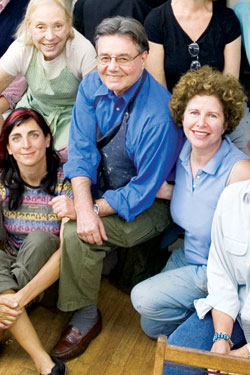
Once a week, a group of 25 artists and friends converge on a tiny downtown studio to paint under the tutelage of caricaturist David Levine and painter Aaron Shikler, who’ve been running the group for more than 50 years. Tonight (at 7:30, on Cinemax), the group makes its televised debut in the inspired (and inspiring) documentary Portraits of a Lady, for which the persevering artists took part in an all-day session creating renderings of former Supreme Court justice Sandra Day O’Connor for a collection to be displayed at the National Portrait Gallery in Washington, D.C. Producer, longtime Painting Group member, and former New York art director Walter Bernard spoke with Vulture about the desire to give his mentors their due, the intricacies of working with legendary photographer Neil Leifer on the film, and the pleasures of discovering the rowdier side of one of the most powerful women in U.S. history.
So, when did you first come up with the idea for this documentary?
I’ve been a member of the Painting Group for about 30 years, starting somewhere around 1975. The Painting Group was started by David Levine, a great caricaturist whose work you can see in the New York Review of Books, and Aaron Shikler, a portraitist. I was thinking of doing a film to honor David and Aaron, but I couldn’t figure out what the premise would be until I read something about the fact that George Washington was painted by over 25 different artists and we’ve come to accept [dollar bill–featured artist] Gilbert Stuart’s as the definitive Washington. Doesn’t mean it’s necessarily that’s the way that Washington looked — Washington was painted by many different artists, and there’s a variety of different looks. So I thought, what if our group, which consists of 25 artists, could paint a great, prominent American figure? That would make a film.
And you recruited Neil Leifer to direct. This isn’t the kind of project one would normally associate with a sports-photography superstar…
Neil’s a great photographer and he’s also done some films, and he and I have always talked about doing a project together. So I approached him and told him what I had in mind and he liked it. So I said, ‘You direct it, we’ll produce it together.’ Neil is very organized, and has a great knowledge of good filmmakers; making this film didn’t really require any extra expertise. We didn’t have to know a great deal about art. We just had to be curious.
I read that your nickname for him is “The Pest.”
Neil is a very… persistent person. Which, by the way, he probably did hone as someone who not only took great photographs in sports, and as the sports world grew, you really had to fight your way into areas and you had to be rather dogged. And one of the great things about Neil is that he keeps at it, he never gives up. So in this case “pest” was meant as a compliment.
There’s a funny scene in the film when you guys try to pay Justice O’Connor the standard model fee…
Yes, absolutely! And she could not accept any payment. I mean, we offered her very little. It was probably under 40 bucks.
A token, then.
Right. I think we pay models something like fifteen bucks an hour. But I never saw the check because he ripped it up! It was big surprise. We didn’t know he was doing it. We were lucky to get it on camera because nobody was paying attention at first, and she was so playful when she was fooling around with Aaron about being paid.
She really has a great personality — I have to admit I was a bit surprised.
We had no idea either. None of us had ever met her aside from David Kennerly. And as you can see, she was very charming. She was funny. She would eat anything; she had no special diet. Her secretary called me and said, “Are you kidding, she’s a cowgirl from Arizona, she’ll eat anything! Just make sure she gets water.” She was so charming that she totally made the film. You never know in a documentary if the star will be a “B” or “C”… whether it would be the paintings, or one of the painters, or David or Aaron…but she was wonderful. We knew that she would be important, of course, but we didn’t know if she would elevate the film.




